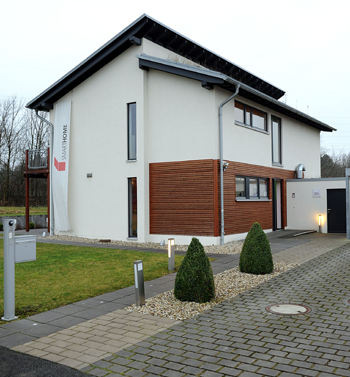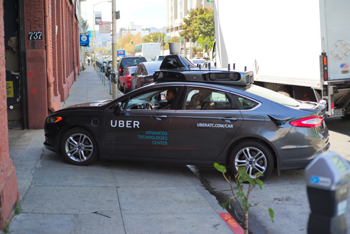Commercial Applications
This section illustrates some of the ways in which Artificial Intelligence's many techniques, singularly and in combination, are being applied across diverse areas, including Smart Homes, Stores and Hotels, Health care and Medical procedures, and Autonomous Vehicles. More details of these and other applications can be found in the links page at the end of this topic.

Smart Homes
The closest AI comes to you personally every day, is in your own home. It permeates your home, provides almost invisible services, and often is accepted as a member of the family. This is a rather odd situation because most of the functions it preforms were not considered problems and were performed manually or at least singularly with simple electronics. But the AI solution certainly makes life "easier". Using Deep Learning Voice Recognition, Alexa, Google Home, Siri, Microsoft Cortana, etc., wake you up, respond to your music requests, play games, keep your calendar, turn off the lights when you are in bed, and these AI powered devices are growing increasingly talented daily. Already using your smart phone, you can let smart locks and garage door controls allow your friends, family and guests into your home. Video-capable doorbells, entryway detectors motion sensors, and fixed monitoring cameras send alerts and allow you to check the security of your home from your smart phone. Smart homes are rapidly becoming AI enabled "hubs" for all Internet connected devises and sensors (IoT). Not only will they simply respond to your voice to set the current temperature but, quickly learn your schedule in relation to a preferred temperature and automatically program itself, and going one step further check your smart phone location and motion sensors to set an empty house efficient temperature level. Add to that a backyard AI camera that distinguishes between deer and humans; and an indoor facial recognition camera that distinguishes between the owner and an unauthorized person and calls the police, as appropriate. Someday soon, or possibly already, you may be able to ask your refrigerator using your smart phone "What can I make for dinner with the ingredients in the freezer"? "What additional ingredients do I need that I don't have?" "Order those ingredients from the store and have them delivered."

Retail and Hospitality
Problem: The retail and hospitality sectors have collected massive amounts of unstructured data, derived from fact-based past experience, detailing how consumers behave. The problem is how to advantageously organize it to provide a better consumer experience, precisely target and predict the consumer's future wants/needs, and add operational value.
Solution: Retailers, using predictive analytics, can create a structured format to anticipate how a given consumer is going to react to a new product, forecast the selling price and anticipate the expected performance over time, and allow retailers to granularly segment consumers to recommend future purchases (e.g. Amazon).
The Hospitality sector uses AI to achieve their primary goals of enhancing consumer experience and loyalty. Their massive collection of data from disparate sources (bookings, surveys, financial transactions, staff observations, etc.) is processed by Augmented Analytics and produces information that significantly segments guest profiles and creates the ability to personalize a guest experience and target future sales. Better customer insights in general lead to operational efficiencies.

Health and Medical
Problem: The health care and medical sectors are coping with immense amounts of fragmented data, from medical histories (in multifarious formats in Electronic Health Records (EHR) and antiquated paper documents), genetic results, to IoT streaming data recorded on wearable devices. The problem is how to pull all this data together and apply AI techniques, with the goals of a) producing precision medicine - drugs or treatments for small groups or individual patients and b) addressing cures (cancer), producing vaccines (Ebola), and realizing medical breakthrough's (complex surgical robots), that can be applied generically to large populations.
Solutions: Long term achievement of these goals is dependent on pulling these fragmented data resources together, using Augmented Analytics, to create compatible data base sets that can be more easily manipulated by multiple AI techniques. In the short term, the use of currently available large sub sets of data, are producing real progress toward these goals.
In Health Care: Detroit Medical Center uses Predicative Analytics to identify patients in their EHR system who consistently visit the ER with flu-like symptoms, and use a combination of preventive measures to encourage early vaccination, which leads to improved patient satisfaction, reduced costs and better use of resources.
In the Medical environment: Machine Learning, Neural Networks, and modern speech creation software (Siri, Alexa), allows researchers to make progress toward implanting a device that reads brain activity, reflects the internal voice of an individual, and bestows the ability to speak to a person rendered voiceless by a stroke or ALS.

Agriculture
Problem: The agriculture industry is embracing AI technologies to solve many different problems. One problem is the overuse of herbicide against plants and weeds that not only is inefficient and costly but harmful to the environment.
Solution: Farmers employee a drone that uses Computer Vision and Machine Learning to identify weeds and, rather that spray the entire field, applies weed killer to only specific weeds. This reduces the amount of chemicals needed and the cost.

Disaster Management
Problem: Disaster management is a two-part conundrum: a) correctly predicting a disaster creates the possibility of mitigation, from evacuations of flood and forest fires areas, to instantaneous reactions to earthquakes; b) struggling to provide aid to the victims of a disaster is a logistic challenge to efficiently coordinate the delivery of necessary food, water, medicine and other supplies immediately and long-term restoration of infrastructure, housing, and government and social interactions. Addressing either of these actions requires the use of AI techniques against massive amounts of disparate data collections.
Solutions: Disaster Prediction for earth quakes relies on in-place individual seismic detectors used to alert the system, but they only sound an alarm when many detectors in a given area sense seismic activity. This system is made faster to gain precious time needed to halt trains, shut down power grids, etc. by using Graphic Processing Units (GPUs), Deep Learning, and different types of Neural Networks.
Disaster Relief presents the logistic problem of locating and identifying the type of supplies needed and coordinating the delivery of them to the best advantage of the recipients. Running massive and disparate data sets of behavior, placement and movement data through Predictive Analytic techniques, Natural Language processes and Machine Language, creates the ability for on-the-ground users to ask specific questions and express requirements resulting in useful answers aiding the distribution of what is needed, when it is needed and where it is needed.

Autonomous Vehicles
Problem: Autonomous Vehicles (AV) are a problem because they are operating on our highways (in limited numbers), are essentially undergoing testing, are operating with little and uncoordinated regulation, and have limited AI capabilities. AV's with these characteristics are commercially available, but should not be described as Autonomous Vehicles. A genuine AV must perform under the strict requirements of AI, in other words. react as a human would in an unknown unknown environment. This is not to say that the outcome of that reaction would be perfect (e.g. not an accident) and should not be expected to be. But it would be statistically far better than human driven vehicles and would provide the proof of acceptance necessary for increasing sales and operations.
Solutions: The U.S. National Highway Traffic Safety Administration (NHTSA) describes various levels of AV's on a scale of 0-5. Very few AV's have reached level 3. A "True AV", would be a 5 on this scale and have an automated driving system (ADS) that acts "as a virtual chauffeur and does all the driving in all circumstances. The human occupants are passengers and are never expected to drive the vehicle." AV's on the road today are using AI technologies in various combinations that primarily include: Cameras, Lidar (light detection and ranging) and Radar to recognize lane lines, speed signs, cyclists and traffic lights. Deep Learning is being employed to create maps and refine vision recognition from this sensor data, but this is primarily for hands-off navigation with a driver present. Even this progress requires countless hours of test driving and large data sets to train ML. Refining the capability of these sensors to unfailingly differentiate objects and improving the software to react correctly (braking, swerving safely, etc.) in a known environment is improving slowly. To produce a level 5 AV, all the data from these assorted sensors must be integrated and processed with the goal of producing a reaction in real-time in an unknown environment, and that will require an operational Artificial Neural Network or AGI.
Continue to Government Users.







